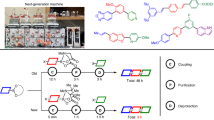Abstract
IN 1940, Cook et al.
1 reported that 2 : 2′-azo-naphthalene (I) produces cancers of the liver in mice. The compound was also given to rats by subcutaneous injection, and with the food; but in this species no neoplastic changes were found in the livers. There is a brief note in the 24th Annual Report of the British Empire Cancer Campaign, 1947, p. 147, that a few small areas of cholangiectasis were observed in three out of eighteen rats receiving this compound by the oral route. No further details have been published, but Dr. A. H. M. Kirby has kindly informed us (see Kirby, Ph.D. thesis, London, 1949) that he obtained a number of foci of hepatoma in rats surviving more than 500 days. These rats were maintained on a balanced diet and were given the azonaphthalene orally. This behaviour is in marked contrast to 4-dimethylaminoazobenzene (II, X = H), which is a liver carcinogen in rats, but which is very much less active in mice. However, 4-dimethylaminoazobenzene is only effective as a liver carcinogen when tested in rats which are maintained on a diet that is low in protein and in riboflavin2, and the original experiments with 2 : 2′-azonaphthalene were completed before the importance of the diet had been established. It therefore seemed of interest to re-test 2 : 2′-azonaphthalene for carcinogenic activity in rats maintained on a suitably restricted diet, for direct comparison with 4-dimethylaminoazobenzene. At the same time, an opportunity has been taken to test other azo-compounds which are also of interest in the study of the relationship between chemical constitution and carcinogenic activity2. 
This is a preview of subscription content, access via your institution
Access options
Subscribe to this journal
Receive 51 print issues and online access
$199.00 per year
only $3.90 per issue
Buy this article
- Purchase on Springer Link
- Instant access to full article PDF
Prices may be subject to local taxes which are calculated during checkout
Similar content being viewed by others
References
Cook, J. W., Hewett, C. L., Kennaway, E. L., and Kennaway, N. M., Amer. J. Cancer, 40, 62 (1940).
For a review, see Badger, G. M., and Lewis, G. E., Brit. J. Cancer, 6, 270 (1952).
Kirby, A. H. M., Cancer Res., 7, 333 (1947).
Miller, J. A., and Miller, E. C., J. Exp. Med., 87, 139 (1948).
Author information
Authors and Affiliations
Rights and permissions
About this article
Cite this article
BADGER, G., LEWIS, G. & REID, R. Carcinogenic Azo-compounds. Nature 173, 313–314 (1954). https://doi.org/10.1038/173313a0
Issue Date:
DOI: https://doi.org/10.1038/173313a0
This article is cited by
-
Sch�dliche und unsch�dliche Farbstoffe f�r Lebensmittel
Zeitschrift f�r Krebsforschung (1955)
Comments
By submitting a comment you agree to abide by our Terms and Community Guidelines. If you find something abusive or that does not comply with our terms or guidelines please flag it as inappropriate.



